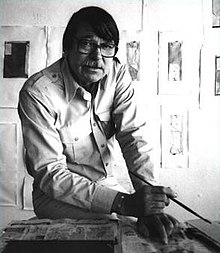Richard Diebenkorn
| Richard Diebenkorn | |
|---|---|

Richard Diebenkorn in 1986
|
|
| Born |
April 22, 1922 Portland, Oregon |
| Died | March 30, 1993 (aged 70) Berkeley, California |
| Nationality | American |
| Known for | Painting |
| Movement | Bay Area Figurative Movement, abstract expressionism, Color Field painting, lyrical abstraction |
Richard Diebenkorn (April 22, 1922 – March 30, 1993) was an American painter. His early work is associated with abstract expressionism and the Bay Area Figurative Movement of the 1950s and 1960s. His later work (best known as the Ocean Park paintings) were instrumental to his achievement of worldwide acclaim.
Richard Clifford Diebenkorn Jr. was born on April 22, 1922 in Portland, Oregon. His family moved to San Francisco, California, when he was two years old. From the age of four or five he was continually drawing. In 1940, Diebenkorn entered Stanford University, where he met his first two artistic mentors, professor and muralist Victor Arnautoff, who guided Diebenkorn in classical formal discipline with oil paint; and Daniel Mendelowitz, with whom he shared a passion for the work of Edward Hopper. Hopper's influence can be seen in Diebenkorn's representational work of this time.
Diebenkorn served in the United States Marine Corps from 1943 to 1945. During the late 1940s and early 1950s, he lived and worked in various places: San Francisco and Sausalito (1946–47 and 1947–50), , New York (1947), Albuquerque, New Mexico (1950–52), Urbana, Illinois (1952–53), and Berkeley, California (1953–1966). He developed his own style of abstract expressionist painting. After WWII, the focus of the art world shifted from the School of Paris to the US and in particular to the New York School. In 1946, Diebenkorn enrolled as a student in the California School of Fine Arts in San Francisco (CSFA), which was developing its own vigorous style of abstract expressionism. In 1947, after ten months in Woodstock on an Alfred Bender travel grant, Diebenkorn had returned to the CSFA, where he adopted abstract expressionism as his vehicle for self-expression. He was offered a place on the CSFA Faculty in 1947 and taught there until 1950. He was influenced at first by Clyfford Still, who also taught at the CSFA from 1946 to 1950, Arshile Gorky, Hassel Smith and Willem de Kooning. He became a leading abstract expressionist on the west coast. In 1950 to 1952, Diebenkorn was enrolled under the G.I. Bill in the University of New Mexico’s graduate Fine Arts department where he continued to adapt his abstract expressionist style.
...
Wikipedia
